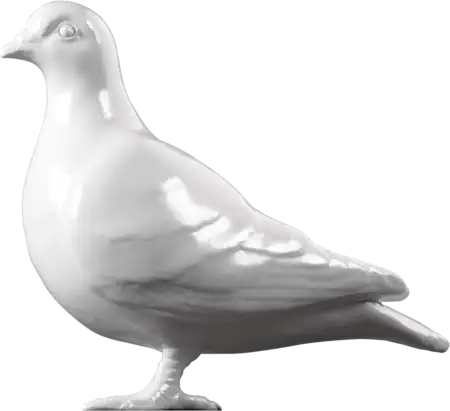18 August 2025 — By Shruti Chakraborty
Say hello to London’s 33 new borough pigeons
Our new Smithfield home welcomes 33 giant pigeons designed by local artists, each celebrating a different borough.
We’re all excited to open our doors to our new museum premises at Smithfield next year. And in the run-up, we’ve got a flock of 33 London pigeons strutting around the building's perimeter.
After launching our new mascot last year, a 2m-tall pigeon-powered design now wraps around the museum's new location. From the herons in Kelsey Park in Bromley to the iconic hammer for Hammersmith and Fulham, each bird showcases a unique design created by London artists, celebrating every corner of this sprawling city.
Why a pigeon? The story behind the icon
Much like dragons protect the City of London, London Museum's pigeon observes London life impartially. Three million pigeons call London home – one for every three residents. These unofficial watchmen see everything from St Paul's rooftops to Soho's back alleys.
The museum's pigeon icon, hand-moulded from Thames clay by a Londoner, sits alongside a glittering splat design based on actual droppings. Born from grit, some love them, others hate them – but these long-time Londoners have found sanctuary here.
The pigeon serves as a blank canvas to exhibit the city and cultural moments across its plumage.
“Each pigeon tells a different story, just like the neighbourhoods they represent”
As Joshua Green, our Head of Design, puts it: “This is a brand identity that belongs to the city.”
The collaboration features designers from across London's 32 boroughs, plus the City of London. They have either lived or worked in the borough they've designed for. You can see works of artists such as Kingsley Nebechi from Enfield, Hattie Newman from Ealing and McBess from Tower Hamlets.
Each pigeon tells a different story, just like the neighbourhoods they represent. They also have elements of the artist’s personal story and style.
What’s your borough pigeon?

The Enfield pigeon design is a visual representation of the creative energy artist Kingsley Nebechi felt within him at the beginning of his creative journey.
The Enfield pigeon reflects the influence of African and Italian art styles that Nigerian-British artist Nebechi is known for. He also pays homage to the 279 bus route that runs through the borough, on which he'd be a regular. Musician-turned-artist, Newman, who moved from Bristol to London, also features the iconic London red double-decker bus.
Rob Flowers’ family has been living in Barking since the 1800s. “I wanted to make a commemorative ceramic style pattern design featuring illustrations of the history of Barking and Dagenham – famous places, people and events,” shares Flowers.
His pigeon design includes “the Dagenham idol, which is about 1,000 years older than Stonehenge… a nod to the fishing industry, which my family were involved in… Bobby Moore, World Cup winning England captain, who was born and raised in Barking.”
You can see a surreal world in Mcbess’ interpretation of the Tower Hamlets pigeon. The French artist, musician and clothing label owner is known for his Fleischer Studios-inspired illustrative style. Try spotting symbols and references to Tower Hamlets in the black-and-white pigeon that’ll take you down a rabbit hole of ‘aha!’ moments.
Both Sutton and Waltham Forest can have a flap over which borough is greener.
Illustrator Jordan Amy Lee "was inspired by the energy of Camden, I wanted my pigeon to be bold, colourful and a little bit rude".
“The artwork – created collaboratively with 33 Londoners – evokes the museum’s role as a shared space”
A sense of ‘home’
Carly Roby and Misha Sofil have designed the City of London pigeon.
Sofil is London-born, and Roby moved from Switzerland. London is a comforting sense of home for both. “The wings on our pigeon were inspired by the dragon statues scattered around the border of the City of London…We used the dragon as a symbol of the city's complex history, along with a silhouette of the skyline, symbolising its modern identity,” explains Carly.
The power of 100,000 Londoners
This collaborative artwork with 33 Londoners highlights the museum’s role as a shared space where London’s history, culture and ideas cross and collide. It’s part of an ongoing project, The Book of Boroughs, which forms a part of the rollout of the museum’s brand identity.

The Wandsworth pigeon is reminiscent of the pigeon post.
Our design partner Uncommon Creative Studio worked with strategic consultants Something More Near to host over 110 hours of debate with a make-up of 503 voices from across London’s boroughs.
They are some of the 100,000 Londoners helping to shape the new museum. Each was asked: How have you made your mark on London and how has London made you, you?
Walk around Smithfield Market, and take a selfie with your borough’s pigeon or even the one you relate to the most. While we work behind the scenes to preserve and transform the historic market buildings into one of the world’s best city museums.

The pigeons are wrapped around the Smithfield Market building, home to the new London Museum.
What happens next
London Museum closed its London Wall location to prepare for this move. The new Smithfield site is one of Europe's largest cultural infrastructure projects.
The Victorian General Market will house permanent galleries when it opens in 2026. And the Poultry Market follows in 2028, with learning spaces and temporary exhibitions.
Now these 33 pigeons stand proudly outside Smithfield as we look ahead to the opening of the museum next year. They're not just art installations. They're London itself, taking flight in a new home.
Shruti Chakraborty is Digital Editor (Content) at London Museum.







